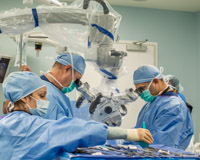If you've been told you may need spine surgery, the idea can sound overwhelming — from the hospital stays and long recovery to the steep costs. But exciting new research from Steven Girdler, MD, a fellowship-trained orthopedic spine surgeon at DISC Surgery Center, shows that many patients can now avoid the hospital entirely.
VIDEO: Dr. Girdler on Artificial Disc Replacement Surgery
In a groundbreaking study led by Dr. Girdler, a Mayo Clinic-trained orthopedic spine surgeon at DISC, more than 1,000 patients underwent Artificial Disc Replacement (ADR) procedures in an outpatient setting with remarkable results.
Let’s break down what that means, why it matters, and how it could impact your treatment journey.
What Is Artificial Disc Replacement (ADR)?
Artificial disc replacement is a common minimally invasive procedure that replaces a damaged or degenerated disc in the cervical spine (the neck area) with an artificial one. It’s commonly used to treat:
ADRs can be completed as a single level procedure, in which a single cervical disc is replaced, two levels, three levels, or more.Traditionally, these procedures were done in hospitals with overnight stays. But that’s changing fast.
The Big Findings: Safe, Efficient and Cost-Saving
Dr. Girdler and his team analyzed 1,684 artificial disc replacements performed on 1,043 patients from 2018 to 2024 at DISC Surgery Centers in Newport Beach and Marina del Rey.
 Here’s what they found:
Here’s what they found:
- There were zero post-op hospital transfers.
- No blood transfusions.
- No readmissions in the immediate recovery period.
- Every patient was discharged within 24 hours.
These results weren't just limited to simple cases either. The study included:
- 433 single-level ADRs (with an average surgery time of 69.8 minutes)
- 579 two-level ADRs (with an average surgery time of 93.4 minutes)
- 31 three-level ADRs (with an average surgery time of 131.8 minutes)
Put simply, outpatient artificial disc replacements are working safely and efficiently, even in more complex cases.
“Combined, these findings reveal the potential for significant cost savings to the healthcare system, benefitting patients, providers and payers alike,” said Dr. Girdler. “ADRs can now be performed routinely in surgery centers without complications, reducing the need for lengthy hospital stays while fostering shorter recovery periods and a quicker return to active lives.”
 Spine surgeons that participated in this research included:
Spine surgeons that participated in this research included:
- Joel S. Beckett, MD
- Robert S. Bray, Jr., MD, FAANS
- Steven J. Girdler, MD
- Brandon Hirsch, MD
- Nick Jain, MD
- Amer Khalil, MD
- Luke Macyszyn, MD, FAANS, FACS
- Rojeh Melikian, MD
- Ali H. Mesiwala, MD, FAANS
- Grant D. Shifflett, MD
Q&A with Dr. Steven J. Girdler
Question: What inspired this study?
Dr. Stephen J. Girdler: As more spine procedures shift from hospitals to outpatient centers, we needed real-world data to ensure this approach was safe and effective. Our patients were thriving after surgery, and we wanted to put numbers behind that success.
 Question: What makes outpatient ADR so effective?
Question: What makes outpatient ADR so effective?
Girdler: It’s a combination of precise surgical technique, the latest technology, excellent patient selection and the efficiency of a specialized ambulatory surgery center like DISC. Patients recover faster because we use minimally invasive techniques and keep everything streamlined from the second they enter our surgery center through their last appointment with us.
Question: Who is a good candidate for outpatient ADR?
Girdler: Many people qualify, but especially those who are in generally good health and are dealing with neck pain, radiculopathy (a “pinched nerve”) or limited mobility due to disc issues. Every case is different, though, so it’s important to be thoroughly evaluated by a spine specialist.
 Question: How does this benefit patients financially?
Question: How does this benefit patients financially?
Girdler: Outpatient surgery reduces overhead and hospital-related costs. Patients typically have lower out-of-pocket expenses, and insurers also benefit from reduced resource use. It’s a win for everyone involved.
Question: What should patients expect recovery-wise?
Girdler: Most people walk out the same day and begin gentle movement within days. We see quicker returns to work, physical activity, and normal routines compared to traditional spine surgery recovery timelines.
 Why This Matters
Why This Matters
Spine surgery no longer has to mean a long hospital stay, an impressive stride in orthopedic surgery thanks to minimally invasive methods. With state-of-the-art outpatient care and a proven track record, artificial disc replacements are becoming a smart, safe and efficient solution for neck and spine issues.
This research adds to a growing body of evidence showing that outpatient spine surgery is not only possible, but it’s often better for patients.
About DISC Surgery Center
Ready to explore whether outpatient ADR is right for you? Contact DISC Surgery Center and take the first step toward a pain-free life with a faster, safer recovery.
About the author
discmdgroup DISC Sports & Spine Center (DISC) is a national leader in minimally invasive spine surgery, orthopedic surgery, and sports medicine care. Our spine surgeons set the standard in artificial disc replacement, spine fusion, discectomy, microdiscectomy and the full spectrum of spine procedures. The group’s orthopedic surgeons advance the state of joint preservation surgery and total joint replacement, including total knee replacement as well as total hip replacement. Our flagship surgery centers based in Newport Beach, Marina del Rey, and Carlsbad serve patients local to Los Angeles, Orange County and San Diego, as well as the rest of the country. Read more articles by discmdgroup.

_.jpg?width=910&height=607&name=What%20Is%20Artificial%20Disc%20Replacement%20(ADR)_.jpg)







